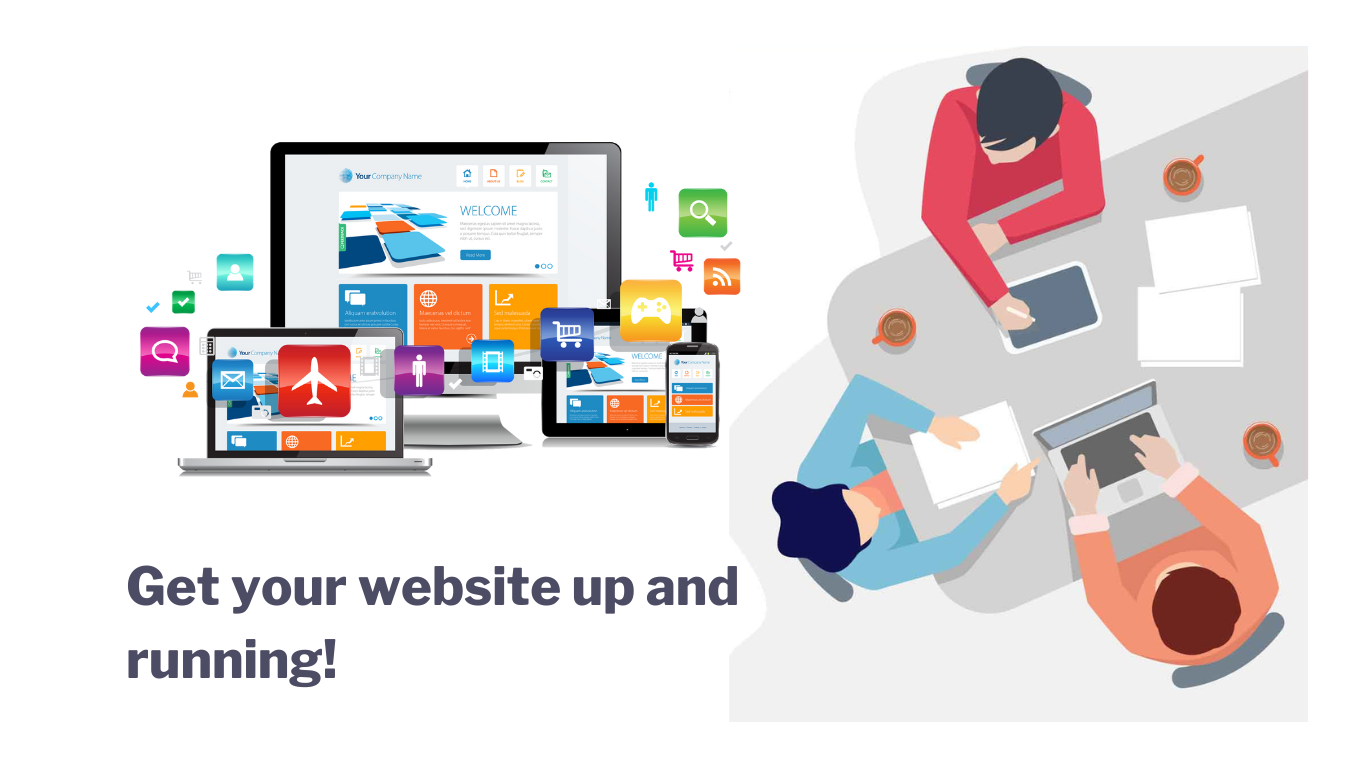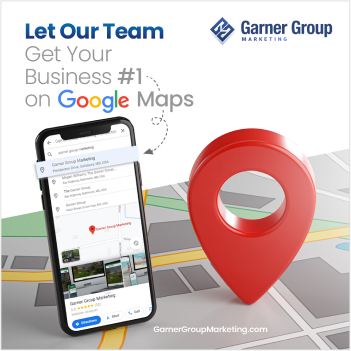Having a well-crafted website has become paramount to online success. However, this can only be achieved through collaboration between clients and a website designer.
76% of website users prioritize the ability to easily find what they’re looking for on a website. Therefore, having an experienced website designer on board is essential to creating a website that is user-friendly and easy to navigate.
If you are feeling lost in the process of creating a website – this article is for you.
From outlining what we’ll need from you to providing tips on collecting and sharing your business goals, we’ll guide you to launch your website the Garner Group Marketing way!
How working with our website designer can bring your vision to life?
Have you ever found yourself spending countless hours trying to build a website that just doesn’t quite meet your expectations?
Perhaps you’ve tinkered with different templates or design elements, but you still can’t seem to capture the essence of your brand.
If this sounds familiar, then it’s time to hire a website designer.
Website designers have the expertise and experience to bring your vision to life in a way that you may not have thought possible.
They can work with you to understand your brand identity, target audience, and business objectives to build a visually appealing website.
With their knowledge of design principles, coding, and user experience, they can help you create a website that functions smoothly and effectively.
By collaborating with the right website designer, you can save yourself time, frustration, and even money in the long run by ensuring that your website is built right.
Whether you’re starting a new business or revamping an existing website, our expert website designers can help you create a website that appeals to your target audience.
What exactly do our website designers need from clients?
1. A clear understanding of your website goals
Your website goals and vision are the foundation for the design development process.
It’s important to communicate your goals effectively to your website designer. Here are some valuable tips to help you do so:
- Define your business objectives. Determine what distinguishes your business from others. Identify what you want to achieve with your website such as increasing online sales, building brand recognition, or improving customer engagement.
- Understand your target audience. Consider what your ideal customers are looking for and how you can best serve their needs.
- Gather inspiration. Collect examples of websites that you like, which will help your web designer understand your aesthetic preferences and design style.
- Write everything down. Keep a record of all the information you gather, so you won’t miss any important details when communicating with your website designer.
Suppose you’re a pet grooming business that wants to increase brand recognition and customer engagement.
In this case, you may start taking actual pictures of pets being groomed in your shop. This will highlight the services you offer and provide visual inspiration for your designer.
Suggesting to add a blog and customer feedback section to your website is also a good idea to build trust and credibility with your audience.
Remember, a clear understanding of your website goals will help guide your website designer in the process of designing your website.
2. Provide insight about your website branding to your website designer
Consistent branding across all channels can increase revenue.
To help streamline the design process of your website, here are some tips on how to outline your website branding:
- Develop a brand style guide. This is a document that outlines your brand’s visual identity. This includes logo, color scheme, typography, and other design elements.
- Your brand logo. If you already have one, make sure to have a vector version of your logo in formats like .eps or .ai.
- Provide website examples in mind. This will help extract ideas or themes for your website and align it with your brand identity.
- Clarify your brand messaging. Your brand messaging will communicate your values, mission, and unique selling proposition (USP).
To give an idea, let’s say you’re a startup accounting firm that specializes in serving small businesses.
You want to establish a brand that is professional, reliable, and approachable. This can be achieved with a sleek minimalist logo and a clean website, with color schemes like blues and grays.
Your website designer can help communicate that your brand is a trustworthy and competent partner who can assist small businesses manage their finances effectively. They can achieve this by designing a website that’s easy to navigate and reflects the firm’s professionalism.
Providing a comprehensive description of your brand identity will assist in creating a design that reflects your business without having to go through rounds of revisions.
3. Present your website content early in the website design process
The foundation of your website is your content.
Providing your website content early in the design process enables web designers to create a website that is optimized for search engines.
Website content includes everything from the text on your homepage to the images and videos that you use throughout your site.
To incorporate your website content into the overall design and functionality of your website, here are some tips to impart to your website designers:
- Provide your relative keywords. Giving your list of keywords to optimize can help you appear on top of the search engine results page.
- Outline the structure of your website content. Decide on the sections you want for your website (Home, Services, About Us, Contact Us, etc.). This will aid in creating a website with a clear, intuitive navigation structure.
- Provide examples. You can suggest using an easy-to-read font, such as Arial or Calibri, or using images and graphics to break up the text, and more.
- Ensure a good supply of up-to-date and high-quality content. Once your website is live, it’s crucial to keep your content fresh and engaging for your visitors.
Your website content can directly impact your website design and functionality. For instance, if you have a large amount of content, you can suggest a drop-down menu or side navigation bar.
Providing a clear idea of your website content can help web designers focus on creating a design that effectively showcases your content.
4. Establish straightforward communication channels with your website designer
Establishing clear channels of communication with your website designer is essential to ensure that your website meets your expectations.
According to studies, businesses that prioritize communications are more likely to succeed in their ventures than those that do not.
To make the website-building process smoother and more enjoyable, here are some tips on how to maintain open communication with your website designers.
- Avoid misunderstandings. Without a doubt, this can lead to wasted time, missed deadlines, and additional costs. Make sure that you and your website designer are on the same page.
- Clearly communicate your goals, expectations, and preferences. Doing so will ensure your vision is realized.
- Get regular updates. This will help you stay informed about the progress of your project. Also, it will allow you to provide feedback and make necessary changes along the way.
- Be open to feedback as well. Don’t forget that your website designer is an expert. They have valuable insights and suggestions for your project which you can consider incorporating into your website.
Take, for example, you’re working to redesign your existing website. You have a lot of content that you want to keep on this site, but you also want to make some significant changes to the designs and layout.
By establishing clear communication channels, you can work with your website designer to make sure that your new site is revamped accordingly while still maintaining all the content that is important to you.
Having a clear communication channel can ultimately lead to a better end result that might even exceed your expectations.
5. Give your website designer a heads-up of what your preferred visual design and layout are
Reports show that 38% of visitors will stop engaging with a website if they find it unattractive. In other words, the design of your website can make or break your online presence.
Your website reflects your brand, it is often the first impression potential clients have on you.
To make a lasting good first impression, here are some tips you shouldn’t overlook when discussing your website with your designer:
- Create a design brief. This is a document that should include your preferred color palette, font types, and design elements.
- Already have a color scheme in mind? List down the hex codes of the colors you prefer.
- Research and gather information. You can browse through other websites that you admire and take inspiration from them.
- Use visual aids. Use mood boards, sketches, or diagrams to better demonstrate your idea to the designer.
- Be specific and concise. Provide necessary feedback and offer suggestions as early as possible to avoid revisions later on.
Imagine you’re a business that sells high-end-products, you’ll want a sophisticated design to reflect the luxury of your brand. On the other hand, if your business deals with child-friendly services, a bright and fun colorful design may be more suitable.
See to it that you provide precise visual details that are aligned with your business’ brand. After all, nobody enjoys a cluttered-design website right?
A well-organized layout, however, can entice visitors to stay longer and explore your website further.
6. Talk to your website designer how you want your website to function
While the visual design is important, it’s equally crucial to focus on the functionality of your site. Functionality refers to how your website operates and how users interact with it.
To successfully communicate your desired website functionalities, here are some tips that can help you gather and organize the information you need.
- Prioritize your goals. Consider both the short-term and long-term goals for your website.
- Research your industry or niche. Visit websites within your niche, take screenshots, bookmark pages, and make notes about the functionalities you like and why.
- Create a list of desired functionalities. This may include the following:
-
User Experience (UX)
This refers to how users feel when they interact with your website. Providing a positive user experience involves ensuring that visitors can easily navigate your website and find what they are looking for with just a few clicks.
-
Mobile Responsiveness
With half of the world’s population now owning a smartphone, only means your site should look and function well on smartphones and tablets.
-
Load Times
According to a survey, nearly 70% of consumers said that page speed affects their willingness to purchase from an online retailer. Thus, a slow-loading website could result in losing potential customers.
-
Call-To-Action (CTA)
Websites with clear CTAs have higher conversion rates than those without. Additionally, a study found that personalized CTAs had 202% higher conversions than generic CTAs.
-
Easily Updatable
As your business grows and evolves, changes to your website are inevitable. Therefore, ask your website designer to create a website that can be updated quickly and easily without requiring extensive technical knowledge.
As a case in point, there’s a fill-out form on your website, make sure to inform where you want that information sent.
Elaborate on your specific requests as you sit down with your website designer, for them to get the full picture of how you want your website to function.
7. Your website designer should know your budget in mind
Tell your website designer your budget before starting the project. This way, they understand the extent of their work.
To get the best value for your money, here are some tips for effectively disclosing your budget to your website designer:
- Be honest, don’t overestimate yourself. Be upfront about your budget from the start. This will avoid surprises and safeguard that your website designer is working within your financial constraints.
- Research on typical cost for website design in your industry. This will give you an idea of what to expect and be a guide in making a realistic budget.
- Prioritize your website’s needs. Write down the features and functionalities that are most important to your business. Prioritizing can help you focus your budget on the most critical elements of your website.
- Be flexible. Your website designer may suggest cost-effective solutions that stay within your budget while still achieving your goals.
- Avoid lowballing. Website design is a complex and time-consuming process, and your website designer needs fair compensation for their expertise.
Working professionally together and being transparent about your budget from the very beginning, can lead to a successful website design project that fits your budget while also exceeding your standards.
8. Set a timeline to help your website designer plan their work
Creating a website can be both exciting and daunting! But allocating a timeline to your website designer can help alleviate some of the time management challenges.
Aside from that, providing a timeline will assure that your website is launched on time. This will prompt you to start promoting your business online and reaching potential clients.
To get your website ready on time, here are some tips on how to discuss your timeline with your website designer:
- Determine your launch date. Decide when you want your website to launch to clearly communicate the timeline to your website designer.
- Set a realistic timeline. Rushing the process can lead to a poor-quality website or missed deadlines.
- Use project management tools. Consider using tools to keep track of tasks and deadlines in an organized manner.
- Be flexible with your timeline. Unexpected delays or issues may arise during the process, so be prepared to adjust your timeline if needed.
- Schedule testing and revisions. Allotting time for these activities will give you confidence that your website is fully functional and ready to go live.
Don’t get frustrated with delays and issues that you may encounter during the process. Instead, concentrate on the necessary steps to get back on track.
Providing your website designer with everything they need before building your website will help create a website that performs effectively according to your business needs.
Clear objectives will hold both parties accountable and make the process of building your website smooth.
Launch your website now!
Garner Group Marketing believes that every business is unique and deserves a website that reflects its individuality. We understand the importance of having a website that not only looks great but also converts visitors into customers.
With Garner Group marketing, you won’t settle for a website that falls short of your expectations. We work closely with you to bring your vision to life, delivering a website that’s both beautiful and functional.
Don’t wait any longer to get your online presence off the ground!
Contact us today to learn more about how we can help you build the website of your dreams!






